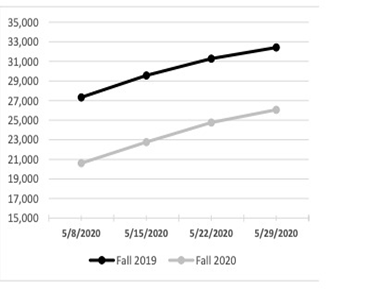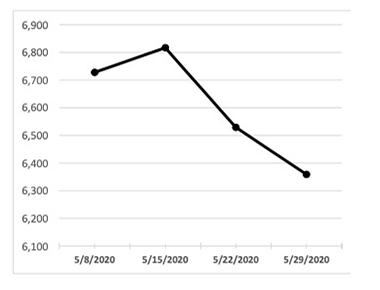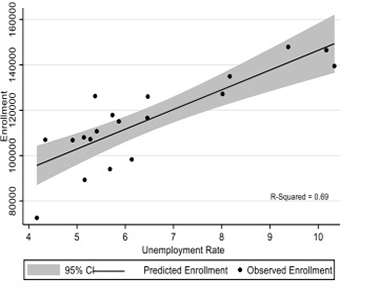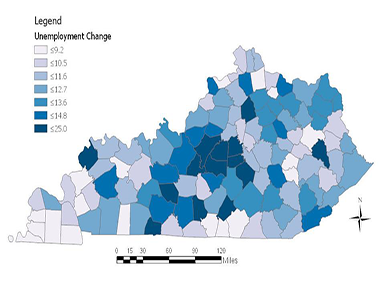
Research Brief
COVID-19: A Lesson in uncertainty
The coronavirus (COVID-19) pandemic has impacted the world in ways that few could have imagined. The outbreak of COVID-19 was sudden and unexpected, and the subsequent shutdown of business and institutional activity created uncertainty across a wide spectrum of economic and social activities. The uncertainty that currently exists hinges on several important questions:
When will the pandemic end and will there be a resurgence of COVID-19 in the fall?
This is not a question we are able to answer, but it is one that is driving leaders in higher education to strategically plan for multiple scenarios. These scenarios include a wide range of potential outcomes that must be considered – both optimistic and pessimistic. Examples of the planning efforts can be seen in new institutional policies that now guide workplace behavior, appropriate personal protective equipment, and other strategies like work-from-home and staggered and flexible schedules. The uncertainty around when the pandemic will end means KCTCS must be flexible and ready to pivot in response to the new reality that now exists. We currently do not know if we will see a resurgence of COVID-19 in the fall and winter cold seasons. According to the Center for Disease Control and Prevention (CDC), a second COVID-19 outbreak is possible in the coming flu season, which would only compound and elongate the problem. The uncertainty that exists is driving leadership to consider all possible outcomes and solutions.
Will students return to pre-outbreak activity levels?
States have started to ease restrictions on social distancing and are now waiting to see if COVID-19 cases increase as a result. Many governors are feeling pressure from their constituents to return to normal business activity due to the impact on jobs and the economy. Whether students will return to normal activity even after restrictions have been fully lifted remains to be seen. Much depends on the ability of institutions to provide a safe environment to resume traditional, in-person instruction. However, perhaps just
as important is the ability of institutions to instill confidence in students (current and prospective) and parents that campus communities are safe and that contingency plans are in place in the event of a resurgence or second wave of the virus.
How will job markets change in response to COVID-19 and the subsequent shutdown?
A key question underlying the current COVID-19 pandemic is whether industries will use the shutdown as an opportunity to reallocate labor into new or emerging areas and significantly reduce labor in areas with declining need. According to the University of Chicago’s Becker Freidman Institute, 42%, or 11.6 million jobs, of all jobs lost due to the COVID-19 outbreak, are likely to be permanently lost. The jobs with the highest risk of being permanently lost are those in industries where the shutdown led to companies closing their doors for good. For example, many restaurants and bars that relied on in-person business have permanently closed. Additionally, automation of industrial processes has been in progress for many years, but it is likely that the COVID-19 outbreak has accelerated that process by encouraging companies to look for alternatives to human employees. Evidence supporting this trend can be seen in the value of stocks for companies that specialize in automation. Since March, U.S. automation giant Rockwell Automation Inc. has seen its stock price increase nearly 90%, suggesting many investors are betting on an increase in automation.
Research Goals:
Given these questions, this report aimed to accomplish two goals:
- Evaluate how KCTCS Enrollment been impacted by COVID-19
- Explore how job markets and occupations have been impacted by COVID-19
KCTCS Enrollment During the Pandemic
Figure 1: Fall 2019 and Fall 2020 Enrollment Trajectories

Figure 2: Gap Between Fall 2019 and Fall 2020 Enrollment Trajectories

Should KCTCS Expect an Enrollment Increase due to the Pandemic?
Figure 3: Association between KCTCS Enrollment and Unemployment

It is possible that many students may not feel comfortable taking in-person courses. Social distancing guidelines have now been hard-wired into our subconscious and it may take some time for students to feel that they can safely come to campus to take courses. Another possibility is that many students may not feel comfortable taking courses exclusively online. As a result, KCTCS may see many students choose to take a gap year. As was shown previously, Fall 2020 enrollment for KCTCS is about 6,300 students less than this same time in the previous year. However, we have also observed a decrease in the gap between Fall 2019 and Fall 2020 enrollment as the state has relaxed restrictions. If easing restrictions puts minds at rest, KCTCS should expect increased enrollment as the economy recovers. However, this may not happen immediately given uncertainty about a possible resurgence of COVID-19 during the fall and winter.
How has the Economy been Affected by the Pandemic?
The impact of the COVID-19 pandemic has been widespread and significant. From January 2019 through February 2020, the unemployment rate in the United Sates was steady at approximately 3.5%. The full-scale shutdown of American businesses and institutions began to be fully captured by economic data in April, when the national unemployment rate hit 14.7%. This increase in unemployment was the largest spike in recent U.S. history, surpassing the unemployment rate of all prior recessions. Map 1 shows that the distribution of the economic impact on Kentucky has not been evenly distributed across counties. Counties with darker shading have experienced greater change in unemployment between April 2019 and April 2020. An interesting pattern to highlight are the clusters of counties with high and low change in central (high) and far western (low) areas of the state.
As shown in Table 1, the impact of the pandemic has not been equal across industry sectors. The industry hit hardest by the COVID-19 induced shutdown has been leisure and hospitality. From May 2019 to May 2020, the unemployment rate in this industry increased from 5.0% to 35.9%. Restrictions on travel, cancelling of sporting events, concerts, and professional conferences has led many in the leisure and hospitality industry to layoff thousands of employees. Other industries experiencing significant increases in unemployment include construction (+12.7%), manufacturing (+11.6%), and wholesale and retail trade (+15.1%).
Map 1: Change in Kentucky Unemployment April 2019 to April 2020

Source: Bureau of Labor Statistics
Note: May 2020 Local Area Unemployment Statistics were not available at the time of this report
| Industry Sectors | May 2019 | May 2020 |
|---|---|---|
| Total Unemployment | 3.4 | 13.0 |
| Nonagricultural private wage and salary workers | 3.3 | 14.0 |
| Mining, quarrying, and oil and gas extraction | 5.0 | 8.4 |
| Construction | 3.2 | 12.7 |
| Manufacturing | 2.3 | 11.6 |
| Durable goods | 2.2 | 13.1 |
| Nondurable goods | 2.5 | 9.3 |
| Wholesale and retail trade | 4.2 | 15.1 |
| Transportation and utilities | 4.1 | 14.2 |
| Information | 3.0 | 10.9 |
| Financial activities | 1.7 | 5.7 |
| Professional and business services | 3.4 | 9.0 |
| Education and health services | 2.4 | 10.1 |
| Leisure and hospitality | 5.0 | 35.9 |
| Other services | 2.9 | 18.4 |
| Agriculture and related private wage and salary workers | 5.4 | 6.5 |
| Government workers | 2.1 | 7.4 |
| Self-employed workers, unincorporated, and unpaid family workers | 2.0 | 9.0 |
Source: Bureau of Labor Statistics
What are the recent trends in jobs in Kentucky?
Figure 4 highlights recent job posting activity in Kentucky from April 1 through May 1. The top 3 industries posting jobs are transportation and warehousing, retail trade, and administrative and support services. The top 3 occupations in Kentucky during this time were heavy truck drivers, registered nurses, and retail supervisors. Finally, the top 3 qualifications found in the April 1 – May 1 job postings were commercial drivers license, licensed practical nurse, and certified nursing assistant. While the job posting activity below highlights the recently posted jobs, it should be noted that overall job posting activity in Kentucky is down substantially when compared to the same time in 2019.
Figure 4: April – May Job Posting Activity
| Top Industries | |
|---|---|
| Transportation and Warehousing | 32,766 |
| Retail Trade | 24,011 |
| Administrative and Support and Waste Management and Remediation Services | 22,745 |
| Health Care and Social Assistance | 19,602 |
| Accommodation and Food Services | 12,838 |
| Professional, Scientific, and Technical Services | 11,563 |
| Manufacturing | 8,380 |
| Finance and Insurance | 6,106 |
| Educational Services | 4,943 |
| Top Occupations | Unique Postings |
|---|---|
| Heavy Truck Drivers | 31,421 |
| Registered Nurses | 8,889 |
| Retail Supervisors | 7,039 |
| Retails Salespersons | 5,688 |
| Customer Service Representatives | 3,885 |
| Light Truck Delivery | 3,648 |
| Stock Clerks and Order Fillers | 3,376 |
| Food Prep. Supervisors | 2,662 |
| Food Prep. Workers | 2,083 |
| Top Qualification | Unique Postings |
|---|---|
| Commercial Driver's License (CDL) | 24,737 |
| Licensed Practical Nurse | 2,496 |
| Certified Nursing Assistant | 2,248 |
| Hazmat Endorsement | 1,327 |
| Nurse Practitioner | 1,156 |
| Bachelor of Science in Nursing (BSN) | 1,142 |
| Master of Business Administration (MBA) | 817 |
| Tanker Endorsement | 779 |
| Transportation Worker Identification Credential (TWIC) Card | 664 |
Source: EMSI
Conclusions
The purpose of this report was to present recent data on the impact of COVID-19 on KCTCS and Kentucky. The report began by discussing several important questions related to the COVID-19 pandemic. We have observed that enrollment is currently down by more than 6,000 students, but we also see that the gap between 2019 and 2020 is decreasing. Using the Great Recession as a benchmark, the current public health induced economic decline produces many new questions and scenarios that are unprecedented. Given the findings presented in this report, there are several recommendations that should be considered as we continue to plan for and navigate these uncertain times.
Recommendations:
- Closely monitor state and national economies as there is a clear link between economic performance and KCTCS enrollment.
- Closely monitor industry demand and gear programming towards occupations that might be most relevant post pandemic.
- Monitor occupations that are likely to experience change due to automation.
- Evaluate job demand at the skill level to make sure programming keeps up with changing skills required for positions.
- Use marketing to promote KCTCS campuses as healthy and safe to help alleviate fears about returning to campus.
- Utilize research that identifies concentrations of problems by demographics, industry, occupation, and location.
Ultimately, the COVID-19 outbreak has been an historic event that has killed more than 100,000 Americans, and its impact will be remembered for years to come. For KCTCS, the pandemic has been a lesson in uncertainty. As we continue to strategize about how to respond it is important to continue to use data and research to inform our decision-making. This report has shown that while the impact of the pandemic has been widespread, it has not been evenly concentrated. We have observed strong variation in unemployment rates by county. Also, we have seen that the impact of COVID-19 has not be evenly distributed across industries or occupations. Finally, recent job posting data suggests that specific occupations and skills are in high demand despite the overall economic disruption. As we continue to monitor the situation in the coming months, it is important that KCTCS persists in seeking to understand the impact of COVID-19. Informed planning and decision making will better enable KCTCS to serve as a catalyst for recovery and further its mission of improving the quality of life and employability of the citizens of the Commonwealth.
